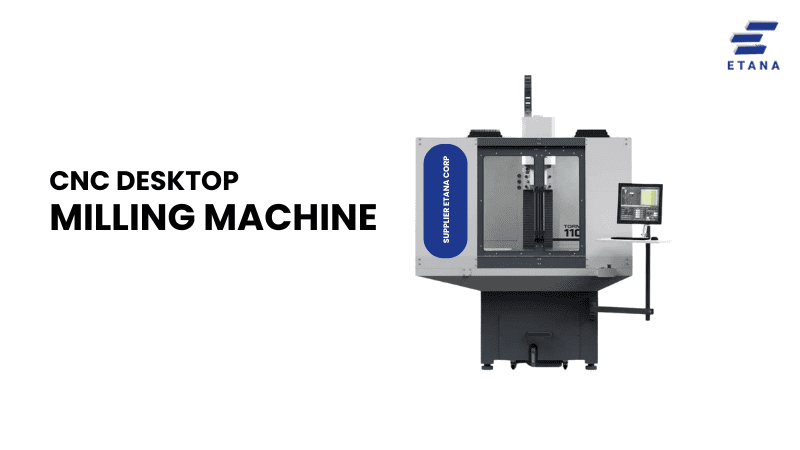Imagine having a robot that can precisely carve out parts from different materials, all from a design you created on your computer. That’s exactly what a desktop CNC milling machine does. CNC stands for Computer Numerical Control, which just means a computer is controlling the machine’s movements. These compact machines are like a miniaturized version of the giant, industrial machines you might see in a factory, but they are designed to fit right on your workbench in your garage or a small workshop in a city like Boston or Los Angeles.
They are perfect for hobbyists, artists, students, and small business owners who need to create intricate and accurate parts without a huge investment. When you’re first getting into the world of CNC, it can feel overwhelming. People in states like Texas and Florida, or anywhere in the U.S., might wonder if it’s a tool they can even use.
But rest assured, modern desktop CNC machines are built with the user in mind. They are easier to set up and operate than ever before, making them an excellent starting point for anyone interested in fabrication.
Every CNC desktop milling machine has a few key parts that work together to bring your digital designs to life. The frame is the machine’s skeleton, providing a stable and rigid platform. A spindle is the motor that holds and spins the cutting tool, which is also called an end mill. The controller is the brain, receiving instructions from your computer and translating them into movements. Finally, stepper motors or servo motors are the muscles that move the spindle along different axes, giving the machine its precision.

A Step-by-Step Guide
The process of CNC milling is a simple and repeatable workflow that anyone can learn.
When you’re ready to buy, you’ll find many choices. It’s important to find a machine that fits your needs. This is where we can help you make an informed decision. For example, if you want a machine for your small business, you may want to check out Etana’s metal fabrication machines to explore options that are built for high performance.
Here’s a quick table to help you compare the key factors.
Feature | For Beginners | For Professionals |
Materials | Softwoods, plastics, acrylics | Metals, hardwoods, composites |
Machine Size | Compact, fits on a desktop | Larger, requires a dedicated space |
Precision | Good enough for hobby projects | High precision, repeatable results |
Spindle | Low power, quieter | High power, faster and stronger |
Budget | $200 – $1,000 | $2,000 and up |
The type of material you want to work with is one of the biggest factors in your choice. Entry-level machines are best for softer materials like wood, plastic, and acrylic. If you want to mill aluminum or other metals, you’ll need a more rigid machine with a more powerful spindle.
Think about where your machine will live. Some machines are small enough for a desk, while others need a dedicated workbench. Consider not only the machine’s footprint but also the space needed for its cables, dust collection, and material storage.
Precision refers to how accurately the machine can create a part. Rigidity is about how well the machine can handle cutting forces without flexing. A machine with a rigid frame and precise components will produce cleaner, more accurate parts, especially with harder materials.
The spindle is the spinning part that holds your cutting tool. A more powerful spindle can cut harder materials faster. The axes (like X, Y, and Z) are the directions the machine can move. Most desktop machines have three axes, but some advanced models have more, allowing for more complex cuts.
Your budget will play a major role. Prices for desktop CNC machines range from a few hundred dollars for a basic hobbyist model to thousands for a professional-grade machine. Don’t forget to factor in the cost of software, cutting tools, and materials.
Before you commit, it’s a great idea to read reviews and watch videos from other users. Look for honest feedback on assembly, ease of use, and what kind of projects people are completing. Websites like Make: Magazine and CNCCookbook are great places to find in-depth comparisons.
With a desktop CNC milling machine, your imagination is the only limit! Here are a few examples to get you started.
The software is just as important as the machine itself. Without it, your machine is just a fancy paperweight.
CAD software is used to create 3D models. Think of it as a digital sculptor’s studio. Popular options include Autodesk Fusion 360 and Onshape, which offer free versions for hobbyists.
CAM software is the translator. It takes your 3D model and creates the toolpaths that the CNC machine will follow. Many CAD programs, like Fusion 360, have integrated CAM features.
This flow is the foundation of every successful CNC project.
Keeping your machine in good shape is key to its longevity.
Prices can range from $200 to over $5,000, depending on the features and intended use.
Absolutely! Many machines are designed specifically for beginners with user-friendly software and extensive online support.
CNC routers are typically for softer materials like wood and plastic, while milling machines are built to be more rigid and can handle harder materials like metal.
No, you don’t. The software handles all the complex G-code programming for you. You just need to learn the basics of the design and toolpath software.
Yes, many small businesses and artists use desktop CNC machines to create products for sale.
This guide has hopefully given you a solid foundation and answered your most pressing questions about what a CNC desktop milling machine is. From understanding the basic components to choosing the right machine and mastering the workflow, you are now equipped with the knowledge to begin your journey. Remember, the key is to start with a project you’re excited about, and the learning process will be fun and rewarding.
The information provided in this article is for educational purposes only. Always follow the manufacturer’s instructions and safety guidelines when operating any machinery. This blog does not endorse any specific brand or product, and all choices should be made after careful personal research.
Muratec (Murata Machinery, Ltd.) delivers cutting-edge solutions across logistics, automation, machine tools, sheet metal machinery, textile systems, and communication equipment — driving innovation and quality to support industrial transformation.

Laguna Tools goes beyond machinery — we’re your partner in precision, productivity, and creativity. Our CNC routers and equipment deliver durability, accuracy, and craftsmanship to help bring your vision to life and grow your business.

Boschert Gizelis operates two privately owned factories and is dedicated to continuous R&D investment to deliver high-quality, technologically advanced sheet metal processing machines that meet the evolving industry needs.

Contact us
WhatsApp us